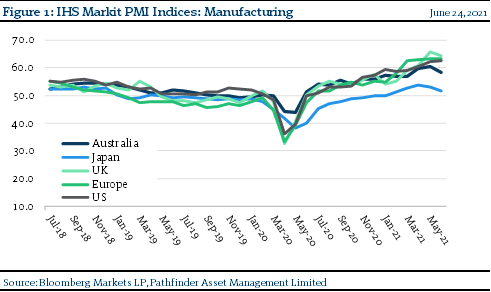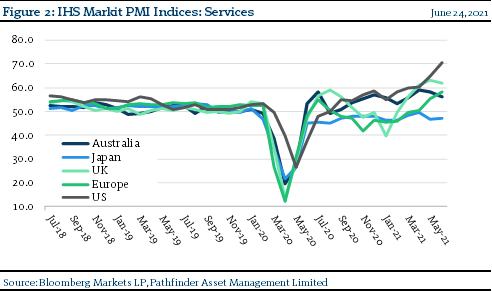Manager Expectations & Economic Recovery
This past week, we noticed data from European and North American countries which indicated that managers in developed markets continue to have high expectations for economic recovery. This is indeed good news and we thought we would share some of the data that we look at on a regular basis. There are a number of different data points, including coincident and leading indicators, put out for a number of reasons by different providers. They are useful but because they are produced independently and by different companies, the constriction and survey methodology can be different leading to difficulty in compatibility across the data points. One data series that we like is called the Purchasing Managers’ Index (PMI). It is put out by IHS Markit, a British company that “provides independent data, trade processing of derivatives, foreign exchange and loans, customized technology platforms”. In short, they are a quantitative data company that helps investors and investment banks.
The PMI consists of several different surveys of purchasing managers from businesses in manufacturing or services. IHS asks questions of 400 companies for 20 segments of their businesses and managers mark 1 for improvement, 0.5 for no change and 0 for deterioration. They do this every month for each country. The data is compiled together and a score above 50 indicates expected improvement over the coming months, while a score below 50 indicates contraction.

- Figures 1 and 2 present PMI data that came out this week for various countries segmented by manufacturing and service type companies. As you can see, manufacturing had a much lower drop during COIVD and has bounced back harder. Service companies, on the other hand, had a much harder time. Global manufacturing is bouncing back in Europe and the UK and services are very strong in the United States.

“This means that” the global economy is recovering and manager expectations continue to be positive, particularly on the manufacturing side. Services are a little slower to recover other than in the US where they are very strong and driving the economy, as a whole, higher. This does makes sense given the stricter lock down measures in Europe.
National Instrument 31-103 requires registered firms to disclose information that a reasonable investor would expect to know, including any material conflicts with the firm or its representatives. Doug Johnson and/or Pathfinder Asset Management Limited are an insider of companies periodically mentioned in this report. Please visit www.paml.ca for full disclosures.
*All returns are time weighted and net of investment management fees. Returns from the Pathfinder Partners’ Fund and Partners’ Real Return Plus Fund are presented based on the masters series of each fund. The Pathfinder Core: Equity Portfolio and The Pathfinder Core: High Income Portfolio are live accounts. These are actual accounts owned by the Pathfinder Chairman (Equity) and client (High Income) which contain no legacy positions, cash flows or other Pathfinder investment mandates or products. Monthly inception dates for each fund and portfolio are as follows: Pathfinder Core: Equity Portfolio (January 2011), Pathfinder Core: High Income Portfolio (October 2012) Partners’ Fund (April 2011), Partners’ Real Return Plus Fund (April, 2013), and Partners’ Core Plus Fund (November 2014).
Pathfinder Asset Management Limited (PAML) and its affiliates may collectively beneficially own in excess of 10% of one or more classes of the issued and outstanding equity securities mentioned in this newsletter. This publication is intended only to convey information. It is not to be construed as an investment guide or as an offer or solicitation of an offer to buy or sell any of the securities mentioned in it. The author has taken all usual and reasonable precautions to determine that the information contained in this publication has been obtained from sources believed to be reliable and that the procedures used to summarize and analyze such information are based on approved practices and principles in the investment industry. However, the market forces underlying investment value are subject to sudden and dramatic changes and data availability varies from one moment to the next. Consequently, neither the author nor PAML can make any warranty as to the accuracy or completeness of information, analysis or views contained in this publication or their usefulness or suitability in any particular circumstance. You should not undertake any investment or portfolio assessment or other transaction on the basis of this publication, but should first consult your portfolio manager, who can assess all relevant particulars of any proposed investment or transaction. PAML and the author accept no liability of any kind whatsoever or any damages or losses incurred by you as a result of reliance upon or use of this publication.